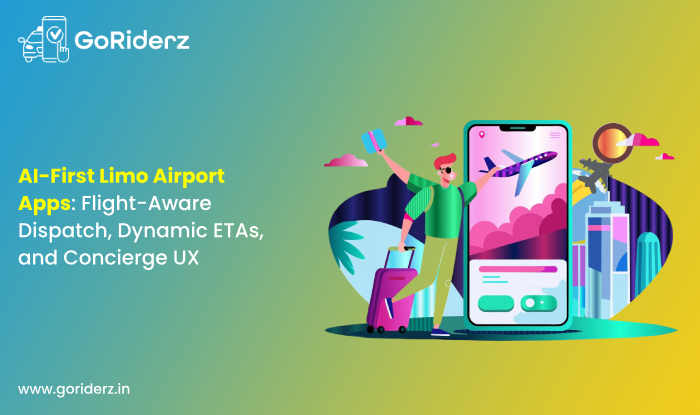
AI-First Limo Airport Apps: Flight-Aware Dispatch, Dynamic ETAs, and Concierge UX
Table of Contents
Limo booking app development pivots on embedding artificial intelligence from the ground up, turning reactive scheduling into proactive orchestration. This means algorithms that anticipate disruptions before they unfold, drawing from vast datasets on traffic, weather, and flight patterns. Developers prioritize modular architectures where AI modules plug into core functions like routing and fleet allocation, ensuring scalability without constant overhauls.
The global airport transfer services market, valued at USD 15.55 billion in 2024, is projected to expand at a CAGR of 10.3% through 2032. (Future Data Stats)
In practice, this foundation streamlines limo airport service app development by automating backend logic. Apps evolve from simple reservation tools into intelligent hubs that learn from each interaction, refining suggestions over time.
The limo software market revenue is expected to grow from USD 500 million in 2025 to 950 million by 2033, registering a CAGR of 8.2%. (Verified Market Reports)
How Does Flight-Aware Dispatch Optimize Fleet Movements?
Flight-aware dispatch leverages real-time integrations with airline APIs to sync limo arrivals with gate times. Gone are the days of static pickups; AI now parses flight statuses, delays, gate changes, and even baggage claim estimates, to reroute vehicles dynamically.
Core Components of Flight-Aware Systems
- API Synchronization: Continuous polling of flight data triggers instant alerts to drivers.
- Predictive Rerouting: Algorithms calculate optimal detours, factoring in road closures and peak hours.
- Driver Notifications: Push updates via app interfaces, complete with revised coordinates and passenger profiles.
| Dispatch Element | Manual Process | AI-Enhanced Dispatch |
|---|---|---|
| Flight Monitoring | Periodic checks via phone | Automated feeds with anomaly detection |
| Vehicle Assignment | First-available basis | Priority matching by vehicle type and proximity |
| Contingency Planning | Ad-hoc adjustments | Pre-computed fallback routes |
This setup minimizes idle time, aligning limo resources precisely with traveler needs in bustling airport environments.
Why Do Dynamic ETAs Matter in Limo Airport Service App Development?
Dynamic estimated time of arrivals adjust on the fly, pulling from GPS telematics, live traffic cams, and historical benchmarks. In limo airport service app development, this feature prevents the frustration of outdated timelines by recalculating every few minutes and notifying all parties.
AI algorithms in ride-hailing platforms now predict estimated time of arrival (ETA) with higher accuracy. (ResearchGate)
Passengers receive layered updates: a base ETA plus variance ranges, fostering trust through transparency. Drivers benefit from buffer zones in their dashboards, allowing smoother transitions between jobs.
In What Ways Does Concierge UX Personalize the Journey?
Concierge user experience layers AI-driven personalization atop standard bookings, transforming apps into virtual assistants. Chat interfaces handle queries on amenities, while recommendation engines suggest add-ons like in-car Wi-Fi based on past rides.
Elements of Concierge UX
- Proactive Suggestions: Tailored prompts for upgrades during booking.
- Seamless Handoffs: Voice-activated check-ins that sync with airport beacons.
- Feedback Loops: Post-ride surveys that refine future interactions.
This approach in limo booking app development ensures passengers feel attended to, from curb to destination.
Conclusion
AI-first limo airport apps redefine ground transport through flight-aware dispatch, dynamic ETAs, and concierge UX, making limo booking app development a gateway to frictionless travel. As limo airport service app development matures, these tools promise coordinated ecosystems where efficiency meets individualized service, easing the chaos of air hubs.
FAQs
1. What role does AI play in limo booking app development?
AI serves as the backbone, enabling predictive features like route optimization and personalized recommendations to enhance overall functionality.
2. How does flight-aware dispatch work in practice?
It connects app systems to airline data for real-time adjustments, ensuring limos align with actual flight outcomes.
3. Why integrate dynamic ETAs into limo airport service app development?
They provide accurate, updating timelines that reduce wait times and build reliability for users.
4. Can concierge UX handle complex passenger requests?
Yes, through natural language processing that interprets and fulfills needs like special accommodations during transit.
5. What should developers prioritize for seamless integration?
Focus on secure data handling and cross-platform testing to maintain performance across varied user scenarios.